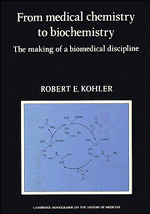Book contents
- Frontmatter
- Contents
- 1 Introduction: On discipline history
- 2 Physiological chemistry in Germany, 1840–1900
- 3 Physiology and British biochemists, 1890–1920
- 4 General biochemistry: the Cambridge school
- 5 European ideals and American realities, 1870–1900
- 6 The reform of medical education in America
- 7 From medical chemistry to biochemistry: the emergence of a discipline
- 8 Unity in diversity: the American Society of Biological Chemists
- 9 The clinical connection: biochemistry as applied science
- 10 Chemical ideals and biochemical practice
- 11 Biological programs
- 12 Epilogue: Toward a molecular biology?
- Location of archival sources and abbreviations
- Notes
- Index
12 - Epilogue: Toward a molecular biology?
Published online by Cambridge University Press: 07 October 2011
- Frontmatter
- Contents
- 1 Introduction: On discipline history
- 2 Physiological chemistry in Germany, 1840–1900
- 3 Physiology and British biochemists, 1890–1920
- 4 General biochemistry: the Cambridge school
- 5 European ideals and American realities, 1870–1900
- 6 The reform of medical education in America
- 7 From medical chemistry to biochemistry: the emergence of a discipline
- 8 Unity in diversity: the American Society of Biological Chemists
- 9 The clinical connection: biochemistry as applied science
- 10 Chemical ideals and biochemical practice
- 11 Biological programs
- 12 Epilogue: Toward a molecular biology?
- Location of archival sources and abbreviations
- Notes
- Index
Summary
Particular scientific styles flourish only where intellectual priorities are congruent with institutional structures and goals. That is the central theme of Chapters 9–11. This process of accommodation is clearest in the case of clinical biochemistry. True, the time was ripe for discoveries in clinical analysis, metabolism, and nutrition; but biochemists' concentration on these problems reflects an institutionalized system of service roles, markets, and professional alliances. Because human and material resources were readily mobilized for clinical biochemistry, this style dominated the discipline for a generation or more. Meanwhile, equally attractive opportunities for discovery in chemical biology did not become fashionable, except in a few marginal contexts where intellectual opportunities were also vehicles for marshaling institutional support. Contexts that provided intellectual support for chemical biology generally also had built-in limits to growth. This was the case in most departments of chemistry and biology and in nonmedical programs of general physiology. Because bioorganic chemistry or chemical biology conferred little strategic or political advantage, these programs did not attract large numbers of biochemists.
This argument assumes a stringent process of selection: intellectual styles that do not fit institutional goals will not survive. This may be a realistic assumption for periods of rapid institutional innovation. Institution builders must be aware of the strategic uses and limitations of disciplinary programs; entrepreneurs must accommodate their ideals to market conditions. Once established, however, institutions are neither fixed nor inflexible; fixed structures can usually be adapted to a wide variety of uses.
- Type
- Chapter
- Information
- From Medical Chemistry to BiochemistryThe Making of a Biomedical Discipline, pp. 324 - 335Publisher: Cambridge University PressPrint publication year: 1982
- 1
- Cited by



